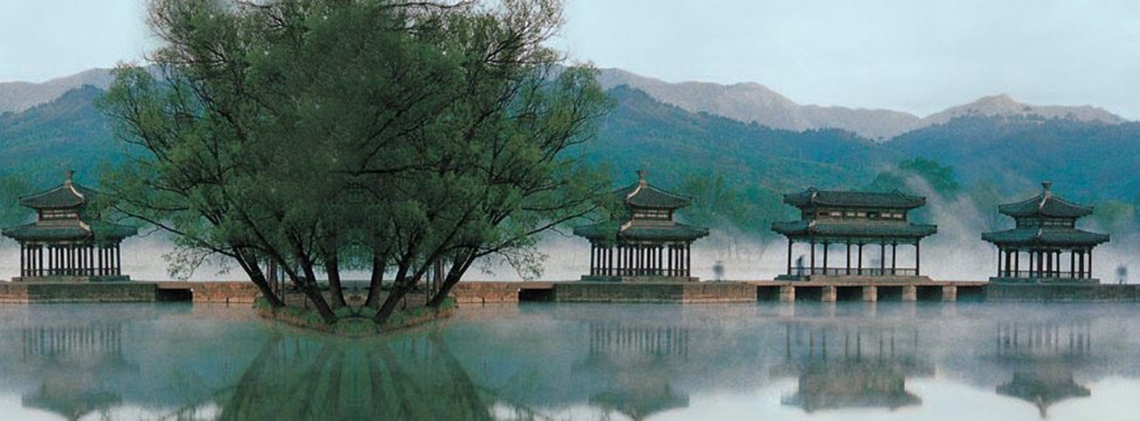
The Art of Chinese Gardens
Splendid
Chi Culture
Topic
The Art of Chinese Gardens
Chinese gardens could easily be called “scholars’ gardens” for they constitute elegant structures that have a scholarly ambiance. The various beautiful scenes in classical Chinese gardens are always connected with the arts of poetry and painting; because of this, they may evoke appreciation and a lingering aesthetic appeal in the visitor’s mind. “Singing birds and fragrant flowers, moonlight, and breezes in the garden” are not only natural phenomena, but a poetic expression of a leisurely, care-free life. In his Peony Pavilion (Mudan ting), the Ming-dynasty playwright Tang Xianzu (1550–1616) wrote scenes such as “Roaming in the Garden” and “Picking up a Painting,” which are not only dramatic literature but garden literature as well. The study of scenes like these can also teach us how to understand the spiritual quality of Chinese gardens. Just as poetry is structured and artistically designed, the same is also true of gardens. Garden design requires an emphasis on the making of imagery. Imagery is given great emphasis in Chinese aesthetics and may be represented by different techniques. For example, shi poetry produces shi poetic imagery; in ci poetry one finds ci imagery. The highest achievements of Chinese gardens rely upon the use of hills, waterways, flowers, trees, ponds, cottages, pavilions, to bring forth a sense of literary and painterly imagery.
The beautiful landscapes of classical Chinese gardens are made up from a handful of basic scenes which generally fall into four categories, namely: “hills and rivers” which comprises rockeries, peaks, ponds, and creeks; “flowers and trees” which also includes grass and moss; “architecture”: halls, studios, towers, terraces, lofts, pavilions, stilt houses, verandas, barges, etc.; and “inscriptions”: these can be either bian’e, horizontal boards inscribed with calligraphy affixed high on the walls or over entrances, or yinglian which are couplets inscribed on scrolls and hung on the pillars of the hall. Naturally, the most important feature of a garden is the landscape; buildings play a secondary role and must be in harmony with the natural scenery. One of the ways in which Chinese gardens are integrated into nature is their asymmetric layout. Even imperial gardens are not as strict in their symmetry as imperial palaces are. The construction of private gardens, the layout of which closely follows the local terrain, show much more versatility and variety.
Although China has a long history of gardens, no early examples survive. The earliest extant ones date mainly from the Ming (1368–1644) and Qing (1644–1911) eras. Even so, the number is considerable. They are located throughout various provinces, cities, and autonomous regions. These numerous gardens may be divided into three categories: imperial gardens, private gardens, and miscellaneous. Imperial gardens refer to those owned by emperors or imperial houses. As emperors possessed abundant resources, their gardens were grand in size, magnificent in style, and ostentatious in embellishments. They were splendid accomplishments of classical garden art. Representative imperial gardens include the Summer Palace (Yihe yuan), the Old Summer Palace (Yuanming yuan), and the Chengde Mountain Resort for Escaping the Summer Heat (Chengde bishu shanzhuang). Private gardens were built by noble clans, high officials, scholars, merchants, and members of the gentry, for whom they were extensions of their residences. Although they cannot compete with the size of imperial gardens, their artful achievements are very high; making use of limited space they create landscapes evoking poetry and painting. In addition to these two main types of gardens, there is still another category that, because of their function, do not fit into either of the previous two. This category contains gardens found at temples, academies, and ancestral halls.
Chinese gardens, on the one hand, are formed around the aesthetic characteristics of natural landscape scenery, but are also a rich, complex art integrating literature, painting, calligraphy, sculpture, bonsai (penjing), drama, and music. For this reason, garden art may be regarded as a crystallization of natural landscape and traditional Chinese culture. Furthermore, Chinese gardens make ideal settings for traditional cultural activities such as poetry, music, chess, calligraphy, painting, singing, drinking, and more. The gardens have also had a certain influence on cultural exchanges and developments.



